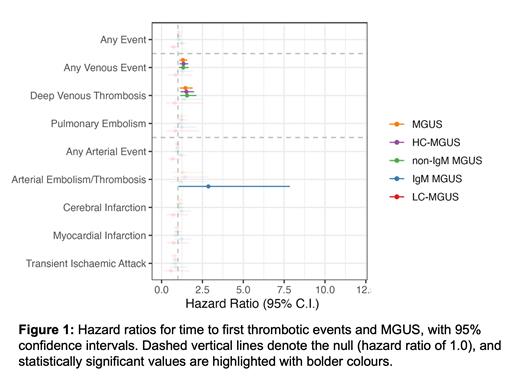Introduction:
Multiple myeloma (MM), Waldenström's macroglobulinemia (WM), and related disorders have been associated with excess risk of thrombosis. Furthermore, medications used to treat these disorders, in particular immunomodulatory agents, have been associated with excess thrombotic risk. Monoclonal gammopathy of undetermined significance (MGUS), the asymptomatic precursor of MM, WM, and related disorders, has also been associated with arterial and venous thrombosis. However, prior studies have been based on cohorts where MGUS was diagnosed as part of the work-up for other unrelated medical disorders. We have shown that these cohort have biased selection of individuals with chronic disease, including autoimmune disease, heart failure, endocrine disorders and more. This selection bias may have led to false associations or overestimation of the relationship of MGUS and thrombotic events.
Aim:
To evaluate the relationship of MGUS and thrombosis in a screened cohort of individuals with MGUS.
Methods:
Data were obtained from the Iceland screens, treats, or prevents multiple myeloma study (iStopMM), a population-based screening study for MGUS and a randomized trial of follow-up strategies with the aim of evaluating the benefits and harms of MGUS screening. As part of the study 75,422 Icelandic residents 40 years and older (54% of the underlying population) have provided their informed consent for the study and were screened by serum protein electrophoresis (SPEP) and free light chain (FLC) assay. The cohort was crosslinked to population-based Icelandic government registries that includes all diagnoses made in the universal healthcare system, recorded as international classification of diseases (ICD) 10 codes. The study exposure was MGUS at screening and the outcome was venous and arterial thrombosis, defined as recorded ICD-10 codes. Events recorded within 90 days of each other were considered the same event. We further analyzed subgroups of M protein isotype and light chain (LC) MGUS. We followed participants prospectively after the date of screening to arterial and venous thrombosis as the endpoint and censoring at death, progression to MM, WM, and related disorders, or end of follow-up. Hazard ratios (HR) for time to first thrombotic event were estimated using Cox regression models, while hazard ratios for recurrent thrombotic events were estimated using mixed-effects Cox regression models with a random intercept. Both prospective analyses were adjusted for age as a non-linear variable and sex. In a secondary analysis, M-protein concentration was included as a non-linear variable into similar models that were restricted to those with MGUS with an M-protein.
Results:
Of the 75,422 screened, 3,353 had MGUS with an M-protein, here termed heavy chain (HC) MGUS, and 315 had LC MGUS. Over a median follow-up of 3.67 to 3.90 years, depending on the outcome of interest, 263 and 3,557 arterial events (20.4 and 13.5 per 1,000 person years) and 260 and 3,092 venous events (20.2 and 11.7 per 1,000 person years) were observed in those with and without MGUS respectively. MGUS was found to be associated with venous thrombotic events (HR: 1.31; 95% CI: 1.08-1.57), in particular deep vein thrombosis (HR:1.46; 95% CI: 1.12-1.90). Of the different MGUS subtypes, this association was only observed in non-IgM MGUS. The results were similar in the recurrent events analysis. IgM MGUS was found to be associated with a higher of peripheral arterial embolic events (HR: 2.86; 95% 1.04-7.85) but this association was not observed in the recurrent event analysis. M-protein concentration was not correlated with the risk of thrombotic events.
Discussion:
In this large population-based study including more than 75,000 individuals screened for MGUS, we found that MGUS, and particularly non-IgM MGUS, was associated with venous thrombotic events. Interestingly, the size of the M-protein spike was not associated with a higher risk for thromboembolic events. Further studies are needed to identify the underlying mechanisms with the goal of identifying subgroups of the MGUS population that may require interventions to prevent thrombotic events, potentially improving the survival and quality of life of those with MGUS.
Disclosures
Hultcrantz:Curio Science LLC, Intellisphere, Bristol Myer Squibb, GlaxoSmithKline: Honoraria; Amgen, Daiichi Sankyo, GlaxoSmithKline: Research Funding. Harding:Bindingsite ltd.: Current Employment, Membership on an entity's Board of Directors or advisory committees. Landgren:Merck: Consultancy, Honoraria, Membership on an entity's Board of Directors or advisory committees, Other: Membership on independent data monitoring committees; Amgen: Consultancy, Honoraria, Membership on an entity's Board of Directors or advisory committees, Other: Membership on independent data monitoring committees; Takeda: Consultancy, Honoraria, Membership on an entity's Board of Directors or advisory committees, Other: Membership on independent data monitoring committees; Janssen: Consultancy, Honoraria, Membership on an entity's Board of Directors or advisory committees, Other: Membership on independent data monitoring committees; Celgene: Consultancy, Honoraria, Membership on an entity's Board of Directors or advisory committees, Other: Membership on independent data monitoring committees; Adaptive: Consultancy, Honoraria, Membership on an entity's Board of Directors or advisory committees, Other: Membership on independent data monitoring committees; Theradex: Consultancy, Honoraria, Membership on an entity's Board of Directors or advisory committees, Other: Membership on independent data monitoring committees. Kristinsson:Celgene: Research Funding; Amgen: Research Funding.


This feature is available to Subscribers Only
Sign In or Create an Account Close Modal